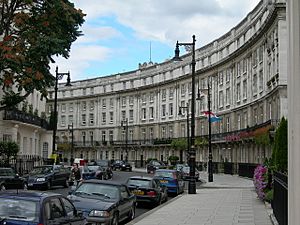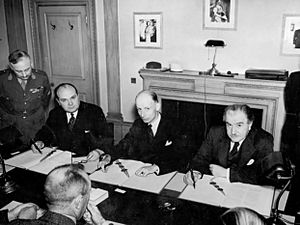Luxembourg government in exile facts for kids
Quick facts for kids
Luxembourg government-in-exile
Lëtzebuerger Exil Regierung
|
|||||||||
|---|---|---|---|---|---|---|---|---|---|
| 1940–1944 | |||||||||
|
|
|||||||||
| Status | Government in exile | ||||||||
| Capital | Luxembourg | ||||||||
| Capital-in-exile | London | ||||||||
| Government | Transitional government | ||||||||
| Grand Duchess | |||||||||
|
• 1940–1945
|
Charlotte | ||||||||
| Prime Minister | |||||||||
|
• 1940
|
Pierre Dupong | ||||||||
| Historical era | World War II | ||||||||
| 10 May 1940 | |||||||||
| 10 September 1944 | |||||||||
|
|||||||||

The Luxembourgish government in exile was the official government of Luxembourg during World War II. It was also called the Luxembourgish government in London. This government had to leave Luxembourg when Nazi Germany invaded the country in 1940.
The government was based in London, England, from 1940 to 1944. It was led by Pierre Dupong, who was the Prime Minister. Three other ministers were also part of this government. The head of state, Grand Duchess Charlotte, also escaped from Luxembourg. The government worked from a building at 27 Wilton Crescent in London. This building is now the Luxembourgish Embassy.
Contents
Why the Government Left Luxembourg
On May 10, 1940, Germany invaded neutral Luxembourg. This was part of a bigger attack on France. The Luxembourgish government, led by Prime Minister Dupong, quickly left the country.
Leaders had already planned to leave if Germany fully occupied Luxembourg. This was because World War II had started in 1939. Even though they planned, the departure was very sudden. German troops advanced so fast that one minister, Nicolas Margue, was captured.
The government first went to Paris, France. When France was about to be defeated, they moved to Portugal. Meanwhile, in Luxembourg, a group of officials tried to manage the country. They even asked the Grand Duchess to come back. They hoped Luxembourg could stay independent under German rule.
However, Germany soon took full control of Luxembourg. On July 29, 1940, Gustav Simon was put in charge. All Luxembourg's government groups were shut down. The Grand Duchess and her government then decided to fully join the Allies.
Life in Exile
The government moved from Paris to Lisbon, then to the United Kingdom. While the government settled in London, the Grand Duchess and her family went to Montreal, Canada. Montreal was a French-speaking city near the United States.
The government in exile worked hard to tell the world about Luxembourg's situation. They wrote articles in newspapers in Allied countries. They also arranged for Luxembourgish radio broadcasts on the BBC. These broadcasts helped people in occupied Luxembourg stay hopeful. In 1942, they encouraged the creation of the Luxembourg Society in London.
Important Decisions and Actions
The government's first step was to protest Germany's invasion. By going into exile, Luxembourg gave up its old policy of being neutral. It joined the countries fighting against the Axis powers. Even though Luxembourg was small, it took part in major agreements with the Allies. These agreements helped plan for the war effort and the time after the war.
Luxembourg signed the Declaration of St James's Palace in 1941. It also signed the Declaration by United Nations in 1942. The country joined the Atlantic Charter in 1941. It also took part in the Bretton Woods Conference in 1944. This conference set up a new international money system.
The government learned from World War I. They focused on making sure Luxembourg would survive and be recognized as a full Ally. In 1944, Luxembourg even contributed to the Allied military. They created the Luxembourg Battery, a group of Luxembourgish volunteers. This group joined the Belgian Brigade Piron.
During the war, the government communicated a lot. They wanted Luxembourg's voice to be heard by the United Nations. They also wanted to keep up the spirits of people in Luxembourg. They published The Luxembourg Grey Book to inform the Allies. They also got Luxembourgish broadcasts on the BBC. The Grand Duchess was very respected by US President Franklin D. Roosevelt. She was invited to the White House many times.
The war also brought Belgium and Luxembourg closer. They had an economic union that had faced problems before the war. Now, facing a common danger, they formed strong economic ties again. Luxembourg had lost its money to Germany. So, Belgium helped the Luxembourgish government with funds from the Belgian Congo. When the war ended, they agreed to restart their economic union. They also signed the Benelux Treaty with the Netherlands in 1944. This treaty aimed to increase their ties even more.
Luxembourgish Soldiers in the War
Luxembourg's military role was mostly symbolic. In March 1944, the first all-Luxembourgish military unit was formed in England. This unit was a gun battery with four powerful guns. They named these guns after the Grand Duchess's daughters: Elisabeth, Marie Adelaide, Marie Gabriele, and Alix.
The unit had about 80 men. It was part of the 1st Belgian Field Artillery Battery, known as the "Brigade Piron." This battery landed in France on August 6, 1944, during the Battle of Normandy. They also helped free Brussels on September 4, 1944.
Many Luxembourgers fought in other Allied armies. For example, Prince Jean, the Grand Duchess's son, served in the Irish Guards starting in 1942. Major Guillaume Konsbruck was an important helper to the Grand Duchess during her exile. The Luxembourg Battery later became the start of the new Luxembourg Army after the country was freed.
Who Was in the Government?
The government in exile had four main ministers.
| Name | Role in Government | Political Party | Where They Were During the War | ||
|---|---|---|---|---|---|
 |
Pierre Dupong | Prime Minister, Minister of Finance, and of the Armed Forces. | Party of the Right | Montreal | |
 |
Joseph Bech | Minister of Foreign Affairs, and other areas like Education. | Party of the Right | London | |
| Pierre Krier | Minister of Work, and of Social Security. | Socialist Workers' Party | London | ||
 |
Victor Bodson | Minister of Justice, Public Works, and Transport. | Socialist Workers' Party | Montreal | |
Planning for the Future
Being in exile gave the government a chance to think about Luxembourg's future. The two socialist ministers, Pierre Krier and Victor Bodson, focused on domestic issues. They wanted to solve problems for the time after the war.
Victor Bodson worked on legal changes to deal with people who had helped the Germans. Pierre Krier, the Minister of Work and Social Security, learned about the idea of a "welfare state" from Britain. This is a system where the government helps its citizens with things like healthcare and education. He was inspired to create plans for social security for everyone in Luxembourg. The government members wanted to avoid another crisis like the one after World War I.
Images for kids
-
The Luxembourg Grey Book (1942) published on behalf of the government to inform the Allied public about Luxembourg's role in the conflict.
See also
- Luxembourg in World War II
- History of Luxembourg






